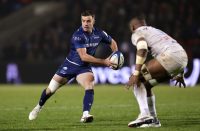There has been a recurrent message doing the rounds since the 2011 World Cup which the existing rugby establishment, based on the IRB and national Unions like the RFU, would do well to heed. It is that coaches and players at the elite end of our sport in both hemispheres are talking about a rebel takeover of international rugby – and top club/provincial competitions like the Heineken Cup and the Super 15 – and many are receptive to the idea.
This is mainly because of the brutal physical burden that ever-increasing fixtures and extended seasons are putting on players and coaches. They are becoming vexed and disillusioned at the failure of the governing bodies to look after the interests of their prize asset – their playing squads – and there are those ready to step into the breach.
The multi-millionaire entrepreneurial businessmen whose finances underwrite much of the professional club game are also growing impatient with the IRB and national Unions for siphoning off treasure chests of cash to service their own ballooning, and often frustratingly inefficient, bureaucracies.
A case in point is England‘s bloated administrative structure, with the RFU Council, its disproportionately powerful 61-man rump of amateur adminstrators, accounting for £1.5m in hospitality and travel expenditure every year.
Rugby’s business tycoons believe the game could be governed much more cost-effectively, efficiently and successfully if the competition infrastructure of the sport was overhauled to accommodate a genuine global season.
Whether the money in the sport would end up lining their coffers instead is a moot point, but those who scoff at the idea of a big money hijacking of professional Rugby Union should remember that there was a serious takeover bid in 1995 when the World Rugby Corporation (WRC) came within an ace of signing most of the world’s leading test players.
WRC was backed by the late Australian media magnate, Kerry Packer, and the 1995 World Cup-winning South Africans led by Francois Pienaar and the Sean Fitzpatrick’s All Blacks, the beaten finalists, were first in the queue to join up.
 This piratical attempt to hijack Rugby Union is chronicled in the book The Rugby War written by the Aussie journalist Peter FitzSimons, and it is an illuminating read for anyone needing a refresher course in tycoon power. An important footnote is that Packer had already transformed cricket in the late 1970s, making the one-day international an established feature of the sport by signing many of the sports biggest stars to his World Series Cricket – the pyjama cricket circus – for three years before shutting it down after securing a 10-year deal to market the sport in Australia.
This piratical attempt to hijack Rugby Union is chronicled in the book The Rugby War written by the Aussie journalist Peter FitzSimons, and it is an illuminating read for anyone needing a refresher course in tycoon power. An important footnote is that Packer had already transformed cricket in the late 1970s, making the one-day international an established feature of the sport by signing many of the sports biggest stars to his World Series Cricket – the pyjama cricket circus – for three years before shutting it down after securing a 10-year deal to market the sport in Australia.
The Australian captain and commentator Richie Benaud said, “It’s because of what happened then, cricket is so strong now.”
Ultimately, WRC’s rugby bid was narrowly thwarted by a counter-thrust from News Corporation, owned by Packer’s Aussie arch-rival, Rupert Murdoch, who negotiated directly with the South African, New Zealand and Australian Unions. By persuading their leading players to return to the fold those Unions eventually signed the SANZAR deal, which has underpinned Tri- Nations and Super Rugby ever since.
The burden on Rugby Union’s elite players is intensifying, and one of the reasons behind the failure of the Northern Hemisphere nations to match their New Zealand, South African and Australian counterparts on a regular basis has been the superior conditioning and rest and recupperation built into the shorter Southern Hemisphere season.
Since the sport turned professional 17 years ago, international players in Europe have had a minimal break between seasons, with most of them having to make do and mend with three weeks holiday in July before trying to cram in some pre-season conditioning before the new 10 month season starts in the first week in September. It is little wonder that 25 per cent of the players in competitions like the English Premiership are injured at any given time.
By contrast, the southern hemisphere elite have generally enjoyed a three to four month close season. However, the advent of the Rugby Championship, which involves an extended international window with the arrival of Argentina, has eaten into it to the extent that, at 38 weeks, it now almost mirrors the 40 week northern season.
Gary Gold, the Bath and former Springbok assistant coach, is one of a growing number of senior figures at the coal-face of the sport who say that the conditions for revolutionary change are ripening:
“Physical conditioning in the Northern Hemisphere is very good, but it is not possible to peak for 40 weeks, and the length of the season is not helping the Northern Hemisphere players. Now the same is happening in the southern hemisphere, and in a couple of years you could see a Kerry Packer-style takeover with someone wanting to start a world league. The conditioning gap is closing with the Rugby Championship, and the Super 15 season split into two blocks. It is going in the same direction as the north by pushing the length of the southern hemisphere season out to 38 weeks.”
Media moguls like the Packers and Murdochs still exist, and with the arrival of the mega-rich in rugby, such as Johann Rupert taking a half share in Saracens and Bruce Craig buying Bath – not to mention the likes of Jacky Lorenzetti across the Channel at Racing Metro – the financial clout is there to re-shape elite Rugby Union. The IRB and the national Unions have to sharpen up their acts right now, or there will be a schism, and they could find themselves on the outside looking in.
One Comment
Leave a Comment
You must be logged in to post a comment.























Pingback: รับทำ SEO สายขาว